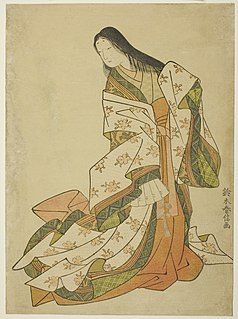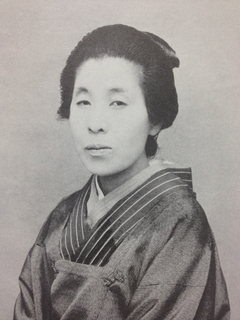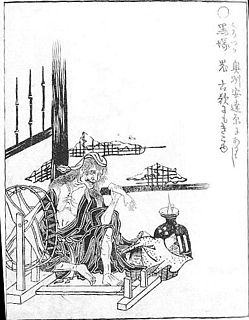Related Research Articles
"Rashōmon" (羅生門) is a short story by Ryūnosuke Akutagawa based on tales from the Konjaku Monogatarishū.

Noh is a major form of classical Japanese dance-drama that has been performed since the 14th century. Developed by Kan'ami and his son Zeami, it is the oldest major theatre art that is still regularly performed today. Although the terms Noh and nōgaku are sometimes used interchangeably, nōgaku encompasses both Noh and kyōgen. Traditionally, a full nōgaku program included several Noh plays with comedic kyōgen plays in between; an abbreviated program of two Noh plays with one kyōgen piece has become common today. Optionally, the ritual performance Okina may be presented in the very beginning of nōgaku presentation.

The Tale of the Heike is an epic account compiled prior to 1330 of the struggle between the Taira clan and Minamoto clan for control of Japan at the end of the 12th century in the Genpei War (1180–1185). Heike (平家) refers to the Taira (平), hei being the Sino-Japanese reading of the first Chinese character and "ke" (家) means family. Note that in the title of the Genpei War, "hei" is in this combination read as "pei" and the "gen" (源) is the first kanji used in the Minamoto clan's name.

Ono no Komachi was a Japanese waka poet, one of the Rokkasen — the six best waka poets of the early Heian period. She was renowned for her unusual beauty, and Komachi is today a synonym for feminine beauty in Japan. She also counts among the Thirty-six Poetry Immortals.

Curlew River – A Parable for Church Performance is an English music drama, with music by Benjamin Britten to a libretto by William Plomer. The first of Britten's three 'Parables for Church Performance', the work is based on the Japanese noh play Sumidagawa of Juro Motomasa] (1395–1431), which Britten saw during a visit to Japan and the Far East in early 1956. Beyond the noh source dramatic material, Britten incorporated elements of noh treatment of theatrical time into this composition. Curlew River marked a departure in style for the remainder of the composer's creative life, paving the way for such works as Owen Wingrave, Death in Venice and the Third String Quartet.

Kiyohime (清姫) in Japanese folklore is a character in the story of Anchin and Kiyohime. In this story, she fell in love with a Buddhist monk named Anchin, but after her interest in the monk was rejected, she chased after him and transformed into a serpent in a rage, before killing him in a bell where he had hidden in the Dōjō-ji temple.

Onibaba is a 1964 Japanese historical drama horror film written and directed by Kaneto Shindo. The film is set during a civil war in the fourteenth century. Nobuko Otowa and Jitsuko Yoshimura play two women who kill soldiers to steal their possessions, and Kei Satō plays the man who ultimately comes between them.
Izutsu is a classic Noh play written by Zeami, the dominant figure in the early history of Noh theatre.

Uemura Shōen was the pseudonym of an important artist in Meiji, Taishō and early Shōwa period Japanese painting. Her real name was Uemura Tsune. Shōen was known primarily for her bijin-ga paintings of beautiful women in the nihonga style, although she produced numerous works on historical themes and traditional subjects. Shōen is considered a major innovator in the bijin-ga genre despite the fact she often still used it to depict the traditional beauty standards of women. Bijin-ga gained criticism during the Taisho era while Shōen worked due to its lack of evolution to reflect the more modern statuses of women in Japan. During bijin-ga's conception in the Tokugawa, or Edo, period, women were regarded as lower class citizens and the genre often reflected this implication onto its female subjects. Within the Taisho era, women had made several advancements into the Japanese workforce, and artistry specifically was becoming more popular outside of pass times for the elite, which opened way for Shōen's success. Shōen received many awards and forms of recognition during her lifetime within Japan, being the first female recipient of the Order of Culture award, as well as being hired as the Imperial Household's official artist, which had previously only employed one other official woman in the position. In 1949 she died of cancer just a year after receiving the Order of Culture Award.

The hannya (般若) mask is a mask used in Japanese Noh theater, representing a jealous female demon. It is characterized by two sharp bull-like horns, metallic eyes, and a leering mouth.

Matsukaze is a play of the third category, the woman's mode, by Kan'ami, revised by Zeami Motokiyo. One of the most highly regarded of Noh plays, it is mentioned more than any other in Zeami's own writings, and is depicted numerous times in the visual arts.
Aoi no Ue is a Muromachi period Japanese Noh play based on the character Lady Aoi from the Heian period novel The Tale of Genji. It is an example of the fourth category of "miscellaneous" Noh plays. Aoi no Ue was the first of many Noh plays based on The Tale of Genji. It is sometimes attributed to Zeami Motokiyo or to his son-in-law Zenchiku; the extant version of the text is likely a reworking of a version written for the troupe of a contemporary, Inuō.

The Eight Views of Ōmi are traditional scenic views of Ōmi Province which is now Shiga Prefecture in Japan.
Dōjōji (道成寺) is a famous Noh play of the fourth category ("miscellaneous"), of unknown authorship. Traditionally it is said to be written by Kan'ami and revised by Zeami, while others assign it to Kanze Nobumitsu; there are many variations in different texts, and a popular adaptation for kabuki theatre titled Musume Dojoji. It originated from a longer 15th century play called Kanemaki. It is set in the Buddhist temple Dōjō-ji in Kii Province, telling the story of a vengeful serpent-spirit and a temple bell. It is practically the only Noh play to use a substantial prop—a huge bell.

Bonshō, also known as tsurigane or ōgane are large bells found in Buddhist temples throughout Japan, used to summon the monks to prayer and to demarcate periods of time. Rather than containing a clapper, bonshō are struck from the outside, using either a handheld mallet or a beam suspended on ropes.

Ushi-no-Toki-Mairi or ushi no koku mairi (丑の刻参り) refers to a prescribed method of laying a curse upon a target that is traditional to Japan, so-called because it is conducted during the hours of the Ox. The practitioner—typically a scorned woman—while dressed in white and crowning herself with an iron ring set with three lit candles upright, hammers nails into a sacred tree of the Shinto shrine. In the modern-day common conception, the nails are driven through a straw effigy of the victim, impaled upon the tree behind it. The ritual must be repeated seven days running, after which the curse is believed to succeed, causing death to the target, but being witnessed in the act is thought to nullify the spell. The Kifune Shrine in Kyoto is famously associated with the ritual.

Kurozuka is the grave of an onibaba in Nihonmatsu, Fukushima Prefecture, Adachi District or the legend of that onibaba. It lives in Adachigahara and it is told in legends as the "Onibaba of Adachigahara." The Kurozuka is actually the name of the mound in which this onibaba is buried, but nowadays it can also be used to refer to the onibaba as well. Also based on this legend are the noh titled Kurozuka, the nagauta and kabuki performance Adachigahara, and the kabuki jōruri Ōshū Adachigahara (奥州安達原).
Aisome-gawa, also known as Some-gawa (染川), is a Japanese Noh play. The libretto's author is unknown, but it was being performed as early as 1514. It is in present repertoires of two of the major Noh schools, Kanze and Konparu. The story concerns a former lover of the high priest of the Dazaifu Tenman-gū who travels to Kyūshū to see him, but is tricked by his jealous wife into committing suicide. The priest prays at his shrine, and the deity, Tenman-Tenjin, manifests and resurrects the lover. The play was modified early on because of disruption at performances. It influenced several later works of literature.

Kyōganoko Musume Dōjōji (京鹿子娘道成寺), commonly called Musume Dōjōji, is a kabuki dance drama. It is the oldest surviving Noh-based Kabuki dance drama, which tells the story of a maiden who dances before a bell in the Dōjō-ji temple and then reveals herself to be a serpent-demon. The work is noted for its sequence of dances during which the performer dances for nearly an hour with nine changes of costume. It may be considered the most important piece in the kabuki dance repertoire, one that the onnagatas are required to learn to show their mastery of classic dances. It is classified as one of the hengemono that involve quick change of costumes and roles. Geisha and other dancers may also learn to perform parts of the dance as solo buyō dance pieces.
The Sunken Temple is a 1987 novel by Satoko Kizaki. It was translated into English in 1994 by Carol A. Flath. While it was well received in Japan, reviewers of the English version had mixed feelings.